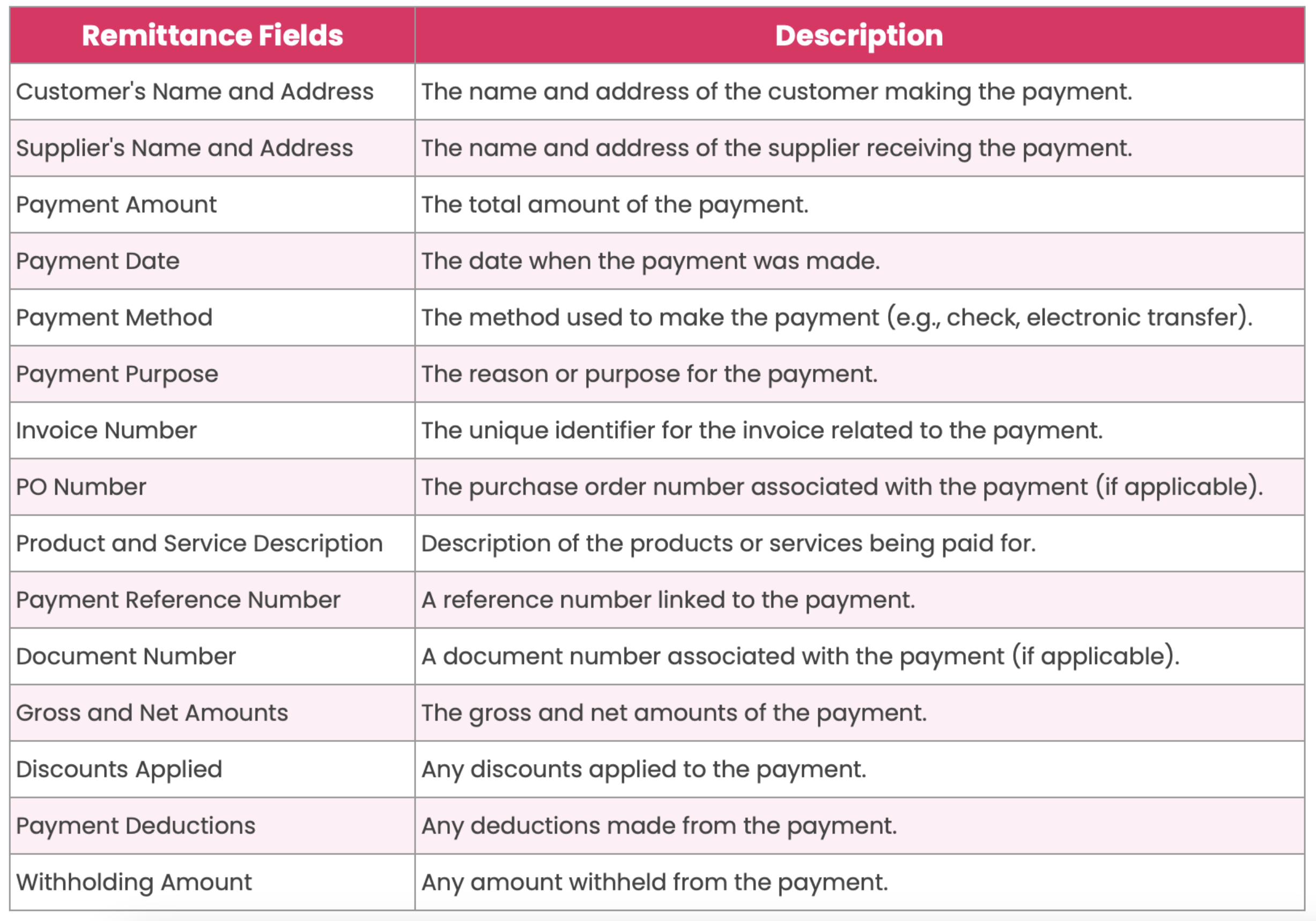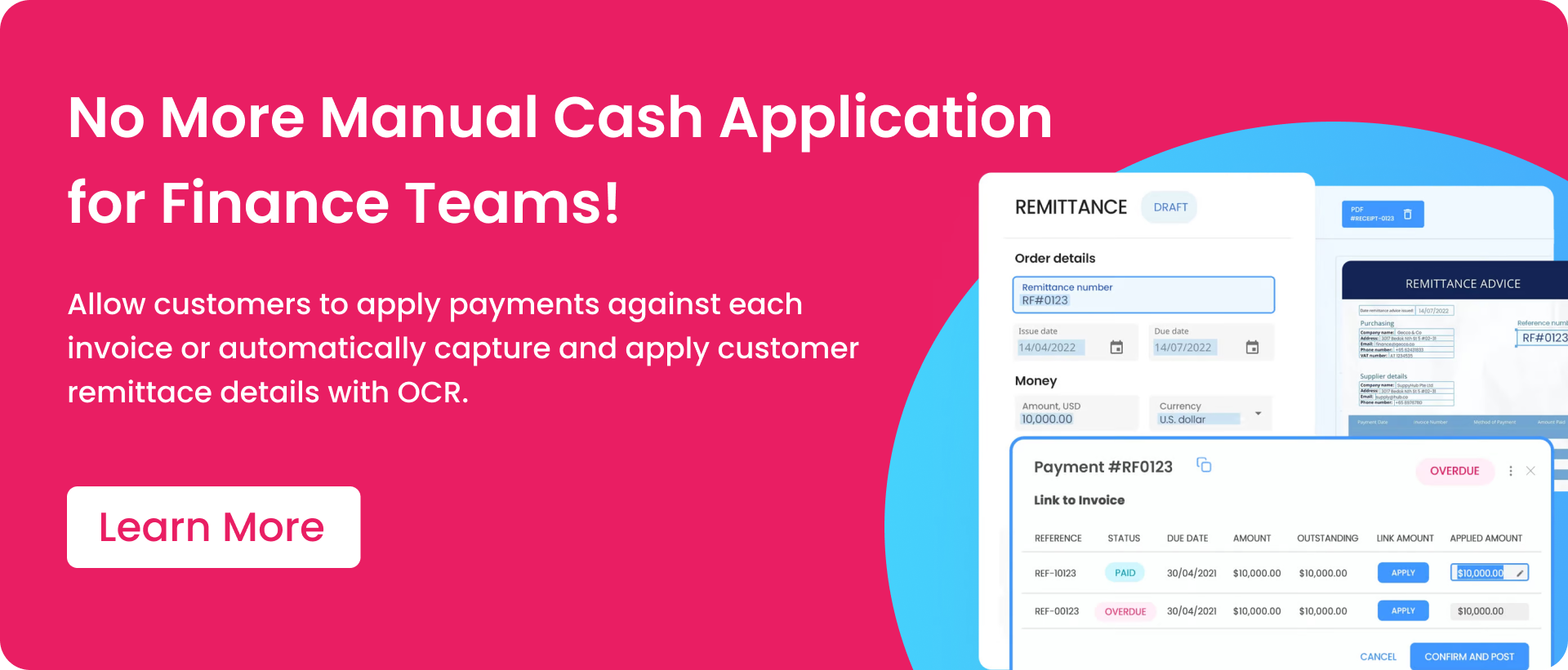Understanding invoicing is important for both vendors and customers. Customers can send remittance slips to help suppliers match a payment to an invoice. Suppliers, in turn, can ask for remittance advice to improve how they handle incoming payments.
Remittance advice is crucial for the cash application process. It helps accounting teams match incoming payments to the correct invoices. However, sourcing and understanding payment slips can be tough because there is no standardized format that all companies use. This often means AR staff have to do manual matching, which takes a lot of time.
To avoid these issues, learn more about what remittance advice is and why it’s important for managing your accounts receivable processes.
What is Remittance Advice?
The term “remittance” refers to a payment directed to or from another party in the form of bills, invoices, or international transactions. It also includes personal money transfers to friends and family.
When customers make a payment, they often use a document called “remittance advice” to let the supplier or vendor know which invoice the payment is for or to confirm that the payment is in progress.
Remittance advice is a crucial document that serves as a communication tool between customers and businesses. The document helps businesses do month-end reconciliation of their accounts receivable records.
Details Included in Remittance Advice
The details in remittance advice can change depending on how the payment is made. For example, if the payment is by check, you might get a detailed paper remittance. For ACH payments, you might not get any extra information.
When you get an email remittance, your accounts team can keep track of the payment and reach out to the sender if needed. To prevent confusion, make sure the remittance advice includes all the necessary details. Usually, it includes:

Example of Remittance Advice
Once your accounts receivable team gets the remittance advice, they will use it to update their records and match the payment to the right invoices. This step is crucial for making sure payments are processed correctly and on time.
The document includes a detailed list of all the invoices that the payment covers. It shows important details like invoice numbers, dates, and purchase order numbers. If the customer took any discounts, that information will also be included.
Here’s an example to help you understand what it looks like:

Types of Remittance Advice
Remittance comes in different forms, namely:
- Basic remittance advice is a printed paper that includes only the invoice number and payment date. It is also the easiest document to make, usually accompanied by a check for the vendor.
- Removable invoice advice is a document that the vendor sends together with the invoice, along with a detachable document for the customer to fill in. The payer will send this back with a check if the payment is manual, or input it online if the payment is digitized.
- Scannable remittance advice is an electronic file that stores and retrieves payment records, allowing vendors to access it digitally. The electronic advice can be of three types:
- Email remittance advice: Customers send remittance information via email, either in the email body or as an attachment, as digital payments become more popular.
- EDI-based remittance advice: EDI, with its alphanumeric characters, is ideal for businesses managing large payment volumes, commonly used by large enterprises to automate accounts receivable.
- Web-based remittance advice: Payment information is sent from a customer to a supplier through a web-based portal, beneficial for high-volume payments, commonly used by retail giants like Amazon and Walmart.
Why is Remittance Advance Important for Businesses?
While remittance advice is not mandatory, it’s definitely helpful to keep them handy for a couple of reasons:
- Better invoice formatting: It is relatively easy to make, and customers can simply reproduce the same format across all the invoices they’re paying.
- Better record-keeping: It is useful for identifying which payments are associated with which accounts.
- Better cash flow management: It is crucial for businesses to manage accounts receivable and accounts payable for effective cash flow maintenance.
- Better reconciliation: It helps suppliers match payments to the correct invoices, saving time on monthly or yearly book closing.
- Better customer relationships: It can guide businesses in providing customers accurate and timely information about their payments, preventing miscommunications.
How to Create a Remittance Slip?
To create a remittance slip, here are the steps to take:
- Gather Payment Information: Collect the customer’s and supplier’s details, invoice number, payment date, and amount.
- Choose a Template: Find an online template or make one using Word or Excel. Add your company’s logo or branding for a professional touch. Try to use the same format each time to avoid confusion.
- Check for Accuracy: Verify all the information to avoid mistakes and unnecessary back-and-forth.
- Add Notes if Needed: Include a thank you note or any other important information.
- Finally, send the slip: For this, you can do it via mail or via a check. There are various methods to send remittance advice, including:
- Paper documents
- Excel sheets
- EDI
- Check
- Accounts payable portal
As more businesses start using accounts payable software, it’s becoming common for customers to send remittance slips through this system. This can be easily connected to the company’s current accounting tool. Accounts receivable professionals might get automatic emails updating them on the status of an invoice, letting them know if it’s still waiting for approval or if it has already been paid.
Remittance Advice Best Practices
To use remittance advice effectively, follow these best practices:
- Use Digital Tools: Digital remittance slips are easier to create and more secure than paper ones.
- Check for Mistakes: Quickly look into and fix any differences between what you have in your accounts receivable records and the remittance slips.
- Give Clear Instructions: Make sure your customers know exactly what information to include on their remittance slips.
- Automate Where Possible: Use automation to make processes more efficient and to reduce mistakes.
- Keep Records Updated: Ensure your accounts receivable records are accurate and up-to-date with the remittance information.
- Train Your Team: Provide training for your staff on how to handle remittance slips to boost their productivity and efficiency.
Challenges with Remittance Advice
Here are the most common challenges that customers and vendors experience when dealing with remittance advice:
1. Discrepancies in Formats and Sources
Getting remittance data from various customers can be tough because there are no standard formats, and sometimes you might not get any data at all. Accounts receivable staff might have to reach out to customers for more information, which can take a lot of time. Also, collecting this data from different sources and formats, especially from AP automation systems, becomes even harder as the number of customers increases.
2. Illegible Remittance Advice
Remittance advice can be hard to read because images might be blurry, characters might be missing, or handwriting might be unclear. Different formats of remittance slips can also make it tough for accounts receivable staff to apply payments accurately.
3. Complex Matching Process
Matching payments to open invoices can be tricky for a few reasons. Sometimes one payment might cover several invoices, other times invoices might be short-paid, or there might be missing payment details. These issues can create a lot of extra work for accounts receivable staff, such as fact-finding, troubleshooting, and communication with customers.
Automate Remittance Capture with Peakflo
If your finance team is wasting time matching payments with remittances, it’s time for a change.
Automated remittance capture can help. It pulls key payment details from remittance advice automatically, which means no more manual data entry. This cuts down on mistakes and speeds up the cash application process. It also makes sure payments are applied to the right invoices quickly and accurately.
Peakflo’s Cash Application Solution enables you to automatically extract accurate and noise-free remittance information. It uses AI-powered OCR to pull accurate payment details directly from emails. The system automatically creates records for payments from scanned receipts and matches them to overdue invoices using reference numbers. This makes it easier for your accounts receivable team to check and adjust details, simplifying cash applications.
By connecting your accounting software and banks with Peakflo, we handle the data matching for you. This saves you around 100 hours a month on reconciliation tasks, letting you focus on more important work.

FAQ
Check remittance advice is a document that accompanies a check payment, providing details such as invoice numbers, amounts, and payment dates. It helps the recipient apply the payment correctly.
Email remittance advice is similar to check remittance advice but is sent electronically via email. It contains payment details and helps streamline the payment reconciliation process.
Remittance information includes details about a payment, such as the amount paid, invoice numbers, and payment date. It helps the recipient understand the purpose and details of the payment.
It serves as a record of payment details but is not considered proof of payment. Proof of payment is typically provided by the payment method used, such as a bank statement or receipt.
Businesses send remittance data to provide payment details to their suppliers, helping them accurately apply the payment to the correct invoices and track their accounts receivable.
Sending remittance data is not always required but is considered a best practice to ensure transparency and accuracy in the payment process, especially for businesses that make frequent payments.
It is not an invoice. It is a document sent by a payer to a payee to provide details of payment, whereas an invoice is a request for payment issued by the payee to the payer.
It is typically issued by the payer, such as a business or individual making a payment to a supplier or vendor, to provide details of the payment.










![Why AI Sales Calls Are Making Good Sales Reps Even Better [2025 Guide] ai sales calls](https://blog.peakflo.co/wp-content/uploads/2025/09/65168cf6-3001-4733-8cbc-12d5684cf449-218x150.webp)


































